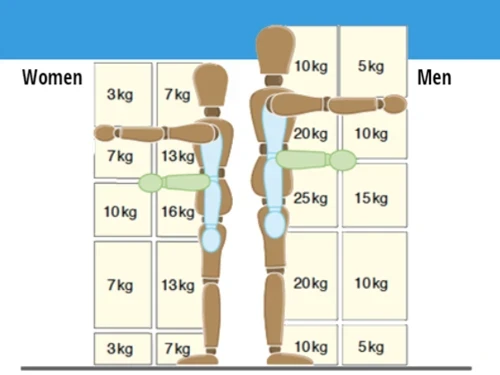What is manual handling? What is meant by the term manual handling?
The term 'manual handling' or 'moving and handling' is defined as:
"The transportation or support of a load by human effort alone."
This effort may be applied directly, for example pushing, pulling or carrying a load or indirectly using a rope or a lever.
In the Manual Handling Operations Regulations 1992 (as amended) (MHOR), the Regulations define manual handling as: "...any transporting or supporting of a load (including the lifting, putting down, pushing, pulling, carrying or moving thereof) by hand or bodily force". The load can be an object, person or animal.
What is manual handling operation regulations 1992? What is the legislation associated with manual handling?
Until a few years ago, accidents caused by the manual handling of loads were the largest single cause of over 7-day accidents reported to the Health and Safety Executive (HSE). The Manual Handling Operations Regulations 1992, as amended in 2002 ('the Regulations or MHOR') were introduced to help reduce these accidents and apply to a wide range of manual handling activities, including lifting, lowering, pushing, pulling or carrying. The load may be either animate, such as a person or an animal, or inanimate, such as a box or a trolley.
However, accidents due to poor manual handling technique, still account for over 25% of all reported accidents and in some occupational sectors, such as the health service, the figure rises above 50%. So in 2003, the NHS in Wales developed the All Wales Passport scheme in Manual Handling. This was to ensure high standards and consistency of manual handling within the NHS in Wales. This has since been adopted by many other NHS trusts and healthcare sectors to try and reduce injuries occurring from manual handling activities.
The other more broad legislation that applies to all work activities not just manual handling is the Health and Safety at Work etc Act 1974 (also referred to as HSWA, the HSW Act, the 1974 Act or HASAWA). This act places a legal duty on employers and employees to comply with all of their health and safety duties and requirements, to take reasonable care of workers and others who may be affected by manual handling activities.
The HSW act and the Manual Handling Operations Regulations 1992, as amended in 2002, place a legal responsibility on employers to carry out risk assessments on any manual handling activity, where there is a risk of personal injury or harm to others. Also to ensure that suitable training is supplied to employees engaged in manual handling activities.
Commodious manual handling online training course covers these legal duties in much more detail and also leads to a RoSPA and ISO9001 quality certificate. This is very useful to demonstrate that the risks of manual handling activities are fully understood and how to manage and reduce these risks.
What does TILE or TILEO stand for in manual handling? What does ICC stand for in manual handling?
Tile or Tileo are acronyms to help you prepare a manual handling risk assessment. The acronym 'TILE' stands for:
TASK, INDIVIDUAL, LOAD, ENVIRONMENT by considering each of these factors a suitable risk assessment can be completed. Tileo simply adds OTHER FACTORS to the tile acronym.
What does ICC stand for in manual handling - this is the Incident Contact Centre (ICC) a 'one-stop' reporting service for work-related health and safety incidents, such as an injury from manual handling that needs reporting under RIDDOR. The ICC is a primarily a call centre, open from Monday to Friday on 0845 300 99 23.
Can manual handling be avoided completely?
Manual handling can be avoided completely, but it is dependant on the task and situation. Often it cannot be avoided completely.
Using machines in factory and warehouse work can often completely replace human effort. By replacing manual handling tasks with machines, such as forklift trucks, hoists and cranes. However there will still be occasions when hazardous manual handling cannot be avoided completely such as delivering heavy parcels, brick-laying, carpet fitting, nursing and many other trades, professions and occupations.
How does good communication reduce the risk of manual handling?
In any manual handling activity where more than one person is involved, then good communication is vital to reduce the risk of injury. A nurse trying to move a patient can greatly reduce the risk by communicating to the patient exactly what they are attempting to do and getting the patient to assist as much as possible.
For example, in a furniture removal team good communication is vital to reduce the risk of manual handling injuries. In any team manual handling activity, all members of the team must know exactly what is expected of them, and good communication is obviously how this is achieved.
What is an ergonomic approach to manual handling?
Safe manual handling is not simply determined by reducing the weight being handled. An “ergonomic” approach to manual handling is needed to reduce the risks in which the contributory factors from the TILE acronym are considered:
Task – e.g. duration and frequency
Individual capability – e.g. age & strength
Load – e.g. shape / weight
Environment – e.g. confined spaces, steps
Ideally avoid all heavy and awkward manual handling. Providing manual handling training is essential, but will not eliminate potential risks alone.
The risk can be reduced in other ways, by changing the load or altering the working environment to make handling safer. Manual handling aids should be used where-ever applicable.



